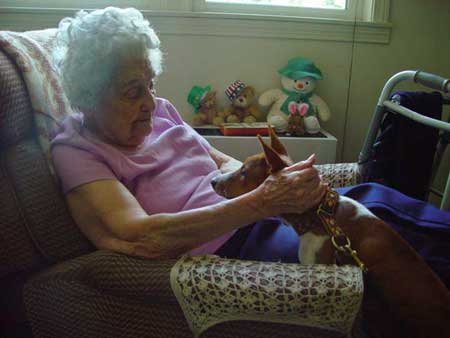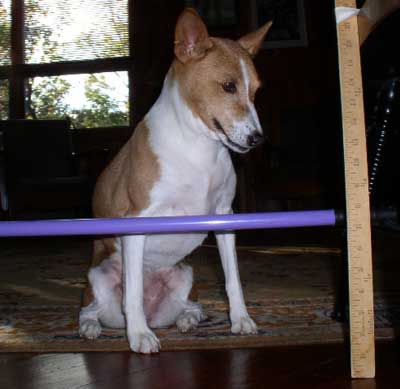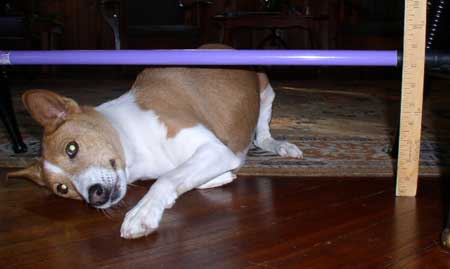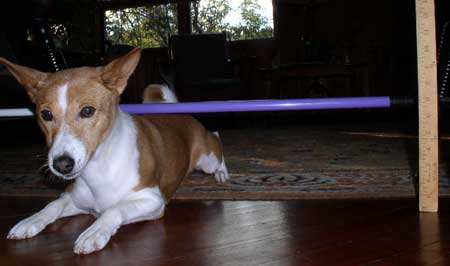Volume XIV, Issue 3,
August 2010
Pages 12 & 13 <previous page next page>
Round Robin Training Conversation
August column: a medly of member contributions

Therapy dog, Fern with Henriette, who is passed away a week past her 98th birthday. We miss her very much.
Lisa Voss
Kenetic Basenjis
NOSE WORK
This sport was created by some law enforcement officers for their friends and family to do for fun. Instead of training their dogs to search for illegal substances, they used 3 target odors one can find at an aromatherapy store, Sweet Birch, Anise, and Clove. Birch is the Level 1 odor. In a trial the dogs have to be able to find the target odors during a box search, a room search, and a car search.
{Ed: Reminds me of a basenji demo at “City Dog,” in NYC, searching for pot. Solo found it pretty quickly, in fact, so fast that he had the time to eat it.}
My mom and I went down to Orange County to my first Odor Recognition Test (ORT) held by the National Association of Canine Scent Work. My mom has been taking classes with her dogs for a couple of months now. I started working informally at about the same time but have not had a chance to attend any formal classes or seminars yet. I am signed up for an Intro to Nosework seminar on June 20th. My mom urged me to just bring Sophie down and give it try since right now there are not alot of opportunities to take an ORT and even if we didn't pass it would be like attending a fun match to get experience. At first I was reluctant since I haven't had a chance to do much practicing lately in places other than my backyard but figured my mom was right and no matter the outcome I would learn something from it.
When I got Sophie out of the car, she seemed to realize all the people and dogs were there for some game and so was she. I got her out with about 3 dogs left ahead of us so we would be "on deck" when called. Finally, our turn came and we entered the room. They escorted us to the start area and read us the rules. The boxes each had 6 holes in the top about inch in diameter. I think there were 20 boxes in two rows but I didn't count. The box had a Q-tip cut in half with birch essential oil on it.
We start the dogs by just having them search boxes for food. You can see L'Ox at 10 weeks old in this video doing one of his first searches, http://www.youtube.com/watch?v=MIOP79SQ2O4
Sophie found the box really quickly, none of her usual checking out every box so I missed her alert and by the time I realized she had alerted she was casting about checking some of the other boxes. At this point, I figured I had blown it but encouraged her to keep searching and she casually checked out two more boxes and then came back and alerted again so I called it and she was right on. So much to my surprise, Sophie is certified on Birch. My mom's girl Bella also certified on Birch. Hopefully she will share her own experience since only the exhibitor being tested is allowed in the room during each test.
I believe that Bella and Sophie may be the first basenjis to pass the ORT for Birch.
Here is Sophie searching the area for a container that has 2 Q-tip halves that have Birch essential oil. The video isn't very long; she caught the scent pretty quick.
http://www.youtube.com/watch?v=Czb1KtdW25M

Sophie
Ruby doing the limbo/Chey Miller
Photos taken for a Basenji Companions limbo contest; we couldn't go in person, but I submitted photos.
Ruby was such a smart little dog. And beautiful. I don't think I will ever stop missing her.



A tad late, as we passed the Fourth, but always relevant:
BOOM! Sometimes ‘Da Bomb’ isn’t All That Great
What to do about Sound Sensitivity in Dogs
by Andrea Stone, CCS CDW
University Canine Learning Academy
Saorsa Basenjis - www.trollsnest.com/soars
With summer fun and anticipated holidays arriving on our near horizon, one of the last things on any of our minds is whether or not our dogs can cope with loud noises. However each of us should, especially with newly adopted or young pets, stop to ask ourselves, “Is my dog afraid of loud noises?”
Most of us have owned or at least known a dog that was afraid of thunder, fireworks or other strange, loud sounds. What can we do to help these pups? Ask any trainer and they will tell you the best course of action when dealing with sound sensitivity in our canine friends is desensitization and counter-conditioning (a.k.a. D & C). In other words, the kindest thing we can do is train our dogs to not only not be afraid of loud noises but that indeed loud noises mean something wonderful is coming their way.
This is usually done by introducing the scary thing at a tolerable level and pairing it with something the dog loves; food is often the most powerful and easily used reward. This method, while very effective, does take time and dedication. There are no short cuts to this type of training.
And of course we need to realize our fuzzy friends have a problem to begin with! It’s easy to miss, especially for those of us who are first time dog owners or simply didn’t notice some of the early warning signs in our pups. Dogs that shy away or spook at loud sounds, or perhaps even just flinch may be sound sensitive. Unfortunately if you discover this shortly before the Fourth of July there is simply not enough time to complete an adequate D&C program. Sometimes sound sensitivity develops; this is not entirely unusual in older pups and adolescent dogs.
Avoidance, leaving town for the Fourth rather than sticking around for the celebration, is a good option. If it’s too late to train for it, you can simply not put the dog into the “scary” situation. For thunder sensitive dogs particularly however, this may not be possible. Weather has a way of being unpredictable! There are other options that help, such as products like the Thunder Shirt and Anxiety Wrap, but these are not always effective enough in the immediate face of a frightening event for our dogs.
So what is a pet owner to do?
Many seek veterinary assistance, such as the use of sedatives like Acepromazine, a commonly prescribed tranquilizer in animals. Here to help answer some questions about it and other medications are Dr. Riedinger and Dr. Eskesen of Hawthorne Hills Veterinary Hospital.
When behavior modification is not possible (due to time constraints, etc) what do you recommend for sound sensitive dogs during holidays like the Fourth of July?
The best approach for noise sensitive dogs is multi-modal [uses more than one method] and utilizes changes in the environment, behavioral modification, use of pheromones and often medications. We encourage owners to start early and work with a veterinarian or skilled trainer to desensitize and counter-condition the dogs to the noises that trigger their panic. An important part of the long-term success is to find the best solution for each dog; because not all patients respond the same it can take weeks to months to address the issues. Untreated noise phobias do not spontaneously improve so doing nothing is not appropriate.
In situations where the dogs are still noise reactive specific medications like Alprazolam, or Diazepam, can be used because they work fairly quickly to lower the panic response. It is also essential to provide the dog a place that is away from the noise (like a basement), or move them to another physical location where the noise is not heard, and ensure that it is a safe location so that they don’t hurt themselves. Using earplugs or cotton to dampen noises, white noise like radios or TV, Anxitane (a product which contains the active ingredient in green tea and has been shown to decrease anxiety in dogs and cats) and pheromones (D.A.P. which has been shown in studies to reduce the fear response in dogs) all provide benefit. A combination approach is very useful.
It is also important to not inadvertently reinforce your pet’s anxiety. Recognize the anxiety signs early – panting, whining, climbing on you, pacing, drooling, barking - ignore the anxious behaviors and have your pet go to their favorite “safe” location. Reward calm behaviors with treats and praise. Definitely do not pet or talk soothingly to your dog during the anxious moments as this can unintentionally teach them that what they are doing is appropriate.** Just as with people, telling a pet to not be afraid seldom works; they need to feel unafraid. Some dogs can feel less anxious if you engage them in an activity that they really enjoy. It is hard to be fearful and happy at the same time.
How do tranquilizers and sedatives work?
Tranquilizers, such as Acepromazine, work to depress the brain functions and cause relaxation and sedation. They do not however, have any effect on decreasing anxiety. Pets with noise reactions almost always are exhibiting a fear response. Sedating them doesn’t take away the anxiety or panic they feel. This is why other drugs, that are true anxiolytics, are recommended. They affect the expression or uptake of neurotransmitters in the brain.
Are they safe?
Most of the medications used in dogs are human drugs and do carry some risks. However, used appropriately these risks can be managed. Some anti-anxiety medications such as Clomipramine and Fluoxetine have veterinary tested and approved formulations and are used regularly for dogs with anxiety issues.
Are sedatives and tranquilizers as effective if the pet owner waits until they notice signs that their friend has become anxious before administering it?
They are less likely to be effective. The best long-term medications take weeks to work so waiting until the last minute limits the medications that can be used. The medications that work more quickly do not work well in every patient; so waiting until they are showing symptoms of anxiety limits the success.
Can sedated animals still perceive the “scary” stimulus, e.g. fireworks, thunder, etc?
Yes. With noise phobias, it is not just the noise; it is the other perceived changes in vibrations, barometric pressures (thunderstorms) and the changes in visual cues (lightning, flashes of fireworks) that can trigger the patient’s response.
Sedation alone does not make the dog feel less fearful. A sleepy person who hears a very loud crash or bang at night does not feel less fearful; knowing what made the noise is what allays the fear. Animals can panic in response to noises they don’t understand which is why counter-conditioning becomes very important. If every time the noise occurs good things happen, pretty soon they are not as worried.
Can some tranquilizers* increase sensitivity to noise?
Yes. This is why we recommend trying the medications well in advance of when they will be needed.
Can some animals overcome the tranquilizing effects, particularly pets with sound sensitivity or in the context of loud noises?
Yes; noise reactions trigger panic and medications alone may not be able to control the animal’s response. This is why sedatives are not the best solution.
Are there pets for which certain tranquilizers are not recommended?
Patients who have other health issues, like liver or kidney disease, glaucoma, are pregnant or lactating, and patients who are on some specific medications may not be able to take sedatives or anti-anxiety medications. It is important to check with your veterinarian before starting any treatment plan.
What alternative medications do you suggest, if any?
Longer term daily anti-anxiety medications such as Anxitane, Clomipramine, Amitriptyline or Fluoxetine are solutions. Many patients with noise reactions also have other anxiety issues. It can take time to identify the best solutions for each dog. Again, start early and work closely with your pet’s veterinarian to ensure that you are treating the whole problem.
Our sincere thanks go to the doctors for taking time out of their busy schedules to answer these questions. At the end of the day all of us, pet owners, trainers and veterinarians, have a common goal: your pet’s good health!
* Karen Overall, MA, VMD, PhD, DACVB, “From Leashes to Neurons”, Tawzer videos states Acepromazine can have this effect
**There is some disagreement amongst behaviorists with regards to the potential for anxiety to be reinforced, often depending upon its severity. See Dr. Pat McConnell Ph.D’s article “You Can’t Reinforce Fear”)


